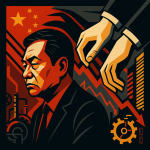Key Points
- The new “Guiding Opinions on Financial Support for New Industrialization,” released by the People’s Bank of China (Renmin Yinhang 中国人民银行) and other key bodies, signals a strategic shift in China’s funding priorities.
- It mandates medium to long-term financing for foundational tech sectors like integrated circuits, industrial mother machines, and basic software, with a “green channel” for IPOs and M&A for companies achieving breakthroughs.
- The policy encourages “patient capital” for early-stage, hard-tech startups, guiding private funds and VCs towards long-term investments through new initiatives and creative models like service-for-equity swaps.
- Significant capital is being directed to upgrade traditional manufacturing towards high-end, intelligent, and green processes, and to fund “future industries” such as new-generation information technology, new energy, and biomedicine.
- A major change for SMEs is the move towards “data credit” and “asset credit” for lending, breaking dependence on core enterprise guarantees and allowing loans based on real-time order books or warehouse receipts.

A new policy on financial support for new industrialization just dropped in China, and it’s a huge signal for investors, founders, and anyone in the tech space.
On August 5, 2025, a powerhouse group of government bodies, including the People’s Bank of China (Renmin Yinhang 中国人民银行), the Ministry of Industry and Information Technology (Gongye He Xinxi Hua Bu 工业和信息化部), and the National Development and Reform Commission (Guojia Fazhan Gaige Weiyuanhui 国家发展改革委), jointly released their “Guiding Opinions on Financial Support for New Industrialization.”
This isn’t just another dry government memo.
It’s a strategic roadmap detailing how China plans to fund its next chapter of technological and industrial growth.
So, what’s actually changing? We broke down the eight key takeaways and what they mean for you.
1. “Long-Term Funding”: Fueling the Deep Tech Revolution
China is going all-in on breaking through critical technology bottlenecks.
The new guidance mandates that banks provide medium to long-term financing for foundational tech sectors. This isn’t about the next viral app; it’s about the hard stuff.
- Key Areas: Integrated circuits (semiconductors), industrial mother machines (high-precision manufacturing equipment), and basic software.
- The Big Perk: Companies that achieve core tech breakthroughs get a “green channel” for listings (IPOs), issuing bonds, and M&A activities. This is a massive fast-track to capital markets.
- Support for “Firsts”: Increased financial backing will go to “three initial” products—think first-of-its-kind equipment, the first batch of new materials, and initial software application solutions. This de-risks innovation for first-mers.

Resume Captain
Your AI Career Toolkit:
- AI Resume Optimization
- Custom Cover Letters
- LinkedIn Profile Boost
- Interview Question Prep
- Salary Negotiation Agent

2. “Patient Capital”: A Big Bet on Early-Stage, Hard-Tech Startups
The government wants to shift investment focus from quick flips to long-term value creation, especially in “hard tech.”
To do this, they’re guiding social capital (private funds, VCs) toward investments that are early-stage, small-scale, long-term, and focused on hard tech.
They’re rolling out new initiatives to make this happen:
- Matchmaking Programs: “One Month, One Chain” roadshows will connect investors with specific industrial chains, while “Thousands of Sails, Hundred Boats” programs will cultivate promising companies for future listings.
- New Investment Models: Venture capital is getting more creative, with official encouragement for models like direct investment and service-for-equity swaps. This is huge for early-stage startups that are rich in talent but low on cash.
- Talent-First Approach: High-level founders and their startups will get a full suite of support, including credit lines and financial advisory services.

3. Upgrading Old School Industries: More Than Just a Fresh Coat of Paint
This isn’t just about building the new; it’s also about upgrading the old.
Traditional manufacturing is getting a major push to transform, with diversified financing channels opening up.
- What’s the goal? To push the manufacturing sector toward a high-end, intelligent, and green future.
- How? Banks are directed to increase credit support for these upgrades.
- Smart Upgrades via Leasing: Companies can now use financial leasing to get their hands on intelligent equipment and green machinery without massive upfront capex. The receivables from these leases can even be securitized and sold, creating a new flow of capital.
- Public Market Moves: Listed companies are encouraged to use tools like overall listings and private placements to consolidate their industries and drive upgrades.

Find Top Talent on China's Leading Networks
- Post Across China's Job Sites from $299 / role, or
- Hire Our Recruiting Pros from $799 / role
- Qualified Candidate Bundles
- Lower Hiring Costs by 80%+
- Expert Team Since 2014
Your First Job Post

4. Pouring Capital into “Future Industries”: Think Next-Gen Everything
China is planting flags in the industries a decade from now, and they’re making sure the capital gets there.
The policy specifically calls out ensuring funds “keep pace” with future-focused sectors.
- Who gets the cash? Emerging industries like new-generation information technology, new energy, and biomedicine can tap into multi-level capital markets.
- The “Smart Money”: Government investment funds and insurance capital are being directed to prioritize what’s next, including future manufacturing, future mobility, and future energy.
- Founder-Friendly Financing: New mechanisms are being put in place to simplify funding for tech companies. This includes an “innovation points system” and easier access to “intellectual property pledge loans,” allowing startups to borrow against their patents and IP.
- New-generation Information Technology
- New Energy
- Biomedicine
- Future Manufacturing
- Future Mobility
- Future Energy

ExpatInvest China
Grow Your RMB in China:
- Invest Your RMB Locally
- Buy & Sell Online in CN¥
- No Lock-In Periods
- English Service & Data
- Start with Only ¥1,000

5. Rewriting the Rules for SME Lending: No Core Customer? No Problem.
This might be one of the biggest game-changers for small and medium-sized enterprises (SMEs).
The policy aims to break the “guarantee dependence,” where a small company’s ability to get a loan depends on the creditworthiness of its largest customer.
China is getting more sophisticated with its green finance tools.
Instead of a blunt “green or not” approach, the new policy is about targeted application of capital for environmental transformation.
- A Pragmatic Approach: Banks are encouraged to support projects in high-carbon industries, but only if they align with genuine green and low-carbon technological upgrades. It’s a “proceed with caution” approach, not a “one-size-fits-all” ban.
- Directing Capital Flow: Green credit and green bonds will be funneled directly to environmental protection, energy conservation, and low-carbon sectors to support the growth of green factories.
- Setting Standards: A specialized financial standards system will be established for this “transformation funding,” signaling a move toward more mature and accountable green investing.

7. Doubling Down on Digital Infrastructure: The Backbone of “New Industrialization”
None of this works without a powerful digital backbone.
The policy ensures that the infrastructure itself is a key investment area.
- Funding the Foundation: Projects for digital infrastructure like 5G and the industrial internet can get medium to long-term loans and raise money through financial leasing and asset securitization.
- Integrated Platforms: Banks are tasked with building digital industrial platforms to offer businesses “one-stop” financing and settlement services.
- AI-Powered Efficiency: Big data and AI will be used to streamline financing procedures and boost service efficiency, especially for SMEs.
8. Playing it Safe: New Rules for Risk and Accountability
With all this new capital flowing, the government is also putting up guardrails to “maintain the bottom line.”
- Follow the Money: Financial institutions must monitor how funds are used to prevent misappropriation.
- No “Internal Competition”: The policy aims to curb “internal competitive” practices, likely referring to subsidy-fueled price wars that destroy value.
- Smarter Risk Assessment: Regulators will conduct joint risk assessments for industrial and financial risks, with high-risk information shared in real-time between departments.
- Dealing with Failure: In a practical move, the policy clarifies that non-performing loans in the manufacturing sector can be handled through legal restructuring and write-offs, acknowledging that not every bet will pay off.
The Big Picture: What This Means for You
This is a clear, government-backed pivot.
The era dominated by consumer internet and real estate is giving way to a new focus on deep tech, advanced manufacturing, green energy, and strategic industrial supply chains.
For founders, it means new, more creative, and more patient sources of capital are coming online, especially if you’re building something hard.
For investors, it’s a roadmap to where the Chinese government and its largest capital pools will be placing their bets for the next decade.
The new era of financial support for new industrialization in China has officially begun. Pay attention.






